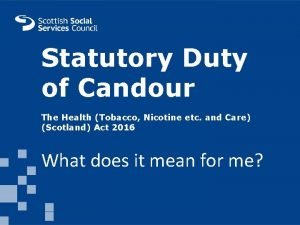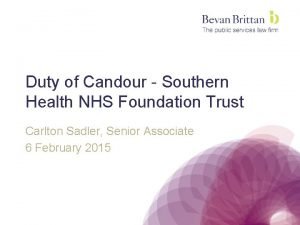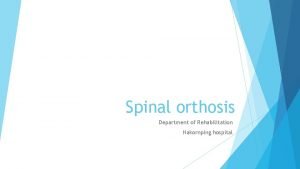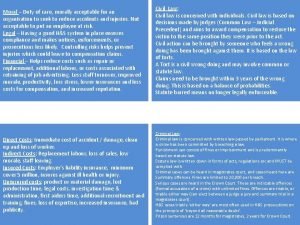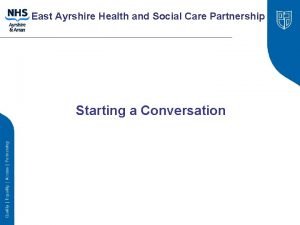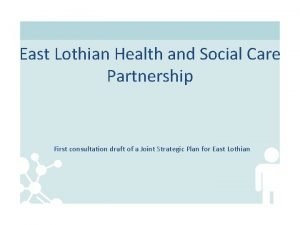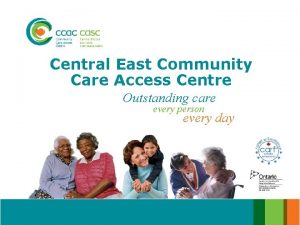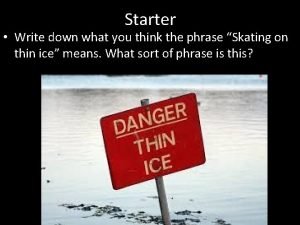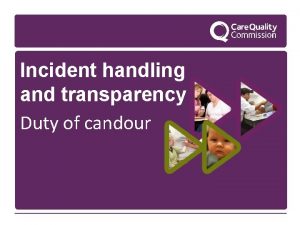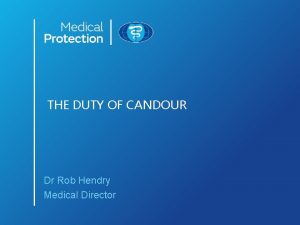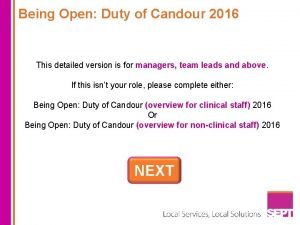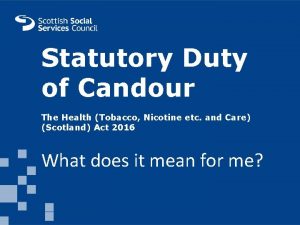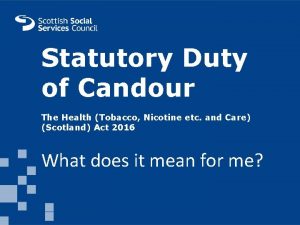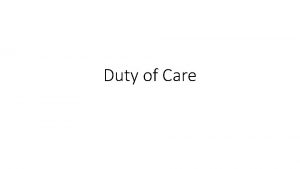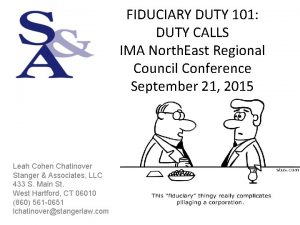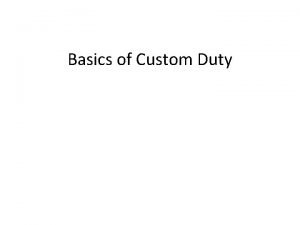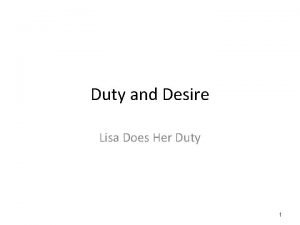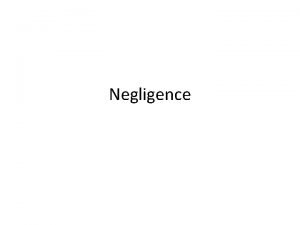DUTY OF CANDOUR LIZ TAYLOR CARE DEVELOPMENT EAST



![3. The notification to be given under paragraph [2][a] must- a) Be given in 3. The notification to be given under paragraph [2][a] must- a) Be given in](https://slidetodoc.com/presentation_image_h2/d605563701c08dfb54468d9891fc6b73/image-4.jpg)
![4. The notification given under paragraph [2][a] must be followed by a written notification 4. The notification given under paragraph [2][a] must be followed by a written notification](https://slidetodoc.com/presentation_image_h2/d605563701c08dfb54468d9891fc6b73/image-5.jpg)



![7 continued • Notifiable safety incident has the meaning given in paragraphs [8] and 7 continued • Notifiable safety incident has the meaning given in paragraphs [8] and](https://slidetodoc.com/presentation_image_h2/d605563701c08dfb54468d9891fc6b73/image-9.jpg)



















- Slides: 28

DUTY OF CANDOUR LIZ TAYLOR CARE DEVELOPMENT EAST

Regulation 20 – Duty of candour • The registered persons must act in an open and transparent way with relevant persons in relation to care and treatment provided to service users. • The intention of this regulation is to ensure that providers are open and transparent with people who use services and other ‘relevant persons’ [people acting lawfully on their behalf] in general, in relation to care and treatment. It also sets out some specific requirements that providers must follow when things go wrong with care and treatment, including informing people about the incident, providing reasonable support, providing truthful information and an apology when things go wrong.

2. As soon as reasonably practicable after becoming aware that a notifiable safety incident has occurred a registered person musta) Notify the relevant person that the incident has occurred in accordance with paragraph 3 b) Provide reasonable support to the relevant person in relation to the incident, including when giving such notification
![3 The notification to be given under paragraph 2a must a Be given in 3. The notification to be given under paragraph [2][a] must- a) Be given in](https://slidetodoc.com/presentation_image_h2/d605563701c08dfb54468d9891fc6b73/image-4.jpg)
3. The notification to be given under paragraph [2][a] must- a) Be given in person by one or more representatives of the registered person b) Provide an account, which to the best of the registered person’s knowledge is true, of all the facts the registered person knows about the incident as at the date of the notification c) Advise the relevant person what further enquiries into the incident the registered person believes are appropriate d) Include an apology e) Be recorded in a written record which is kept securely by the registered person
![4 The notification given under paragraph 2a must be followed by a written notification 4. The notification given under paragraph [2][a] must be followed by a written notification](https://slidetodoc.com/presentation_image_h2/d605563701c08dfb54468d9891fc6b73/image-5.jpg)
4. The notification given under paragraph [2][a] must be followed by a written notification given or sent to the relevant person containing - a) The information provided under paragraph [3][b] b) Details of any enquiries to be undertaken in accordance with paragraph [3][c] c) The results of any further enquiries into the incident d) An apology

5 But if the relevant person cannot be contacted in person or declines to speak to the representative of the registered person- a) Paragraphs [2] and [4] are not to apply b) A written record is to be kept of attempts to contact or speak to the relevant person

6 The registered provider must keep a copy of all correspondence with the relevant person under paragraph [4]

7. In this regulation- Apology means an expression of sorrow or regret in respect of a notifiable safety incident Moderate harm means a) Harm that requires a moderate increase in treatment, and b) Significant, but not permanent harm. Moderate increase in treatment means – an unplanned return to surgery, an unplanned re-admission, a prolonged episode of care, extra time in hospital or as an out patient, cancelling of treatment, or transfer to another treatment area [such as intensive care].
![7 continued Notifiable safety incident has the meaning given in paragraphs 8 and 7 continued • Notifiable safety incident has the meaning given in paragraphs [8] and](https://slidetodoc.com/presentation_image_h2/d605563701c08dfb54468d9891fc6b73/image-9.jpg)
7 continued • Notifiable safety incident has the meaning given in paragraphs [8] and [9] • Prolonged pain – means pain which a service user has experienced, or is likely to experience, for a continuous period of at least 28 days. • Prolonged psychological harm- means psychological harm which a service user has experienced, or is likely to experience, for a continuous period of at least 28 days. • Severe harm – means a permanent lessening of bodily, sensory, motor, physiological or intellectual functions, including removal of the wrong limb, organ or brain damage, that is related directly to the incident and not related to the natural course of the service user’s illness or underlying condition.

7 continued • Relevant person – means the service user, or, in the following circumstances a person lawfully acting on their behalf – a) On the death of the service user b) Where the service user is under 16 and not competent to make a decision in relation to their care or treatment or c) Where the service user is 16 or over and lacks capacity in relation to the matter.

8. In relation to a health service body “notifiable safety incident” means any unintended or unexpected incident that occurred in respect of a service user during the provision of a regulated activity that, in the reasonable opinion of a health care professional, could result in, or appears to have resulted in- a) The death of the service user, where the death relates directly to the incident rather than to the natural course of the service user’s illness or underlying condition, or b) Severe harm, moderate harm or prolonged psychological harm to the service user.

9 - in relation to any other registered person “notifiable safety incident” means any unintended or unexpected incident that occurred in respect of a service user during the provision of a regulated activity that, in the reasonable opinion of a health care professional a) Appears to have resulted ina) The death of the service user, where the death relates directly to the incident rather than to the natural course of the service user’s illness or underlying conditions b) An impairment of the sensory, motor or intellectual functions of the service user which has lasted, or is likely to last, for a continuous period of at least 28 days, c) Changes to the structure of the service user’s body d) The service user experiencing prolonged pain or prolonged psychological harm or e) The shortening of the life expectancy of the service user; or

9 - continued • B- requires treatment by a health care professional in order to preventi. The death of the service user or ii. Any injury to the service user which, if left untreated, would lead to one or more of the outcomes mention in sub paragraph [a]

Company duties / responsibilities • Have procedures that record notifiable safety incidents, and such notifications, and to support the relevant people • Ensure that staff know what they should do and their roles and responsibilities in the process. • Ensure that staff are able to raise concerns where they think the company is not complying with their responsibilities. • Ensure that staff are properly trained. • Ensure that there is a senior manager who has oversight of the process.

Manager responsibilities • Make and keep a factual account of incident • Where appropriate give a verbal apology to the relevant person • Inform the relevant people what further investigations will be made • Be clear about time scales • Produce a written notification that includes an apology where appropriate • Notify the relevant senior personnel in the Company of the incident. • Keep secure written records.

What it doesn’t mean • That duty of candour notifications are issued for every incident.

Scenario 1 • Mrs Jones is being transferred in a hoist with a faulty sling, [that staff were aware of, but was the only one available], during the transfer the sling malfunctions and Mrs Jones ends up on the floor with a broken hip.

It is a duty of candour incident • Because: • Faulty equipment was being used • Mrs Jones will be affected for over 28 days • The Company was not following its own policies and procedures.

What actions should be taken • Incident report completed • Full investigation of the event • Review of policies and procedures • Full apology to Mrs Jones [and her family]. • Retraining of staff • Consideration of equipment availability • Duty of candour letter issued. • Insurance company informed. • Notification to CQC

Scenario 2 • Diane is a home care worker who assists Mr Smith with his medication. His family are also involved but there is a clear plan in place which stipulates who gives which medication. On the morning of the 3 rd Diane gives Mr Smith his tablets as usual, but then realises that there are not as many left in the bottle as there should be. She makes some initial enquiries and discovers that the family have already visited and given Mr Smith his medication. He has therefore received a double dose, she rings his GP and is advised that there is no cause for concern and to just record the incident.

It is not a duty of candour incident • Because: • Mr Smith is not affected for 28 days or more • There is no negative impact on the individual

What actions should be taken • Review of policies and practice • Review of care plan • Incident report completed. • Consider whether Mr Smith is due an apology and if so issue one • Discussion with family re who is giving medication • Praise the member of staff for taking the right action.

Scenario 3 • Miss Hussein is walking down the corridor and slips on a wet floor, after being checked over she suffers no apparent injury and continues with her day. Your initial investigation discovers that the wet floor was due to someone having left a tap running and a washbasin in another resident’s bedroom overflowing.

It is not a duty of candour incident • Because: • No injury to Miss Hussein • At this stage there is no evidence that this is anything other than an unfortunate accident

What actions should be taken • Incident report completed • Check as to whethere is an issue regarding overflow from wash basin – • Ensure repairs actioned if necessary • Care plan for Miss Hussein reviewed • Checks put in place for at least 24 hours

Scenario 3 continued • A week following her fall, Miss Hussein complains of pain in her hip, an examination at the local A & E results in the discovery of a small fracture in her femur which does not require surgery and she is placed in a plaster cast. It is not definitely clear whether this is the result of the slip, but there have been no other falls of which you are aware.

It is a duty of candour incident • Because: • Miss Hussein will be affected for 28 days or more.

What actions should be taken • Incident form updated • CQC notification completed or updated • Review whether further investigation is needed of original incident • Review whether all appropriate action was taken after original incident. • Duty of candour letter issued although this may not include an apology unless the investigation reveals that there was a fault that caused the washbasin to overflow that had not been addressed.
 Www.gdc-uk.org
Www.gdc-uk.org Duty of candour
Duty of candour What is duty of candour
What is duty of candour Duty of care care certificate
Duty of care care certificate Care certificate standard 14 answers
Care certificate standard 14 answers Taylor brace indications
Taylor brace indications Types of care primary secondary tertiary
Types of care primary secondary tertiary Moral duty of care
Moral duty of care What is the horizontal movement of air called
What is the horizontal movement of air called Kalahari desert on africa map
Kalahari desert on africa map East is east and west is west
East is east and west is west North east and north cumbria integrated care system
North east and north cumbria integrated care system East ayrshire health and social care partnership
East ayrshire health and social care partnership East lothian health and social care partnership
East lothian health and social care partnership Central east community care access centre
Central east community care access centre Department of finance and administration
Department of finance and administration June's portfolio includes 177 shares
June's portfolio includes 177 shares Good hangman phrases
Good hangman phrases You see jody's new dog yesterday
You see jody's new dog yesterday ____ judy and liz at last month's meeting?
____ judy and liz at last month's meeting? Liz quintero
Liz quintero Liz pellicano
Liz pellicano Liz lochhead last supper
Liz lochhead last supper Liz whetham
Liz whetham Liz i've age
Liz i've age Box room liz lochhead
Box room liz lochhead Liz lochhead view of scotland/love poem
Liz lochhead view of scotland/love poem Liz sneddon bivariate
Liz sneddon bivariate Liz nichols art
Liz nichols art

